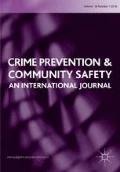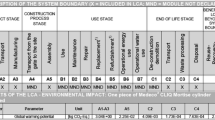Abstract
The use of crime prevention technology continues to expand within the urban environments of post-industrial cities. Target-hardening technologies such as alarms, shutters, bars, gates, walls and CCTV are increasingly being used to protect retail, industrial and residential properties. The use of security shutters on windows in residential settings in Western Australia is a relatively recent development. This trend is increasing, despite a lack of evidence to support their effectiveness in reducing crime. This article investigates crime and security shutters in a residential setting and reports on the perceptions of 353 respondents (residents in a Perth suburb). The survey explores perceptions of crime and ‘eyes on the street’ and contrasts perceptions of crime associated with shuttered and non-shuttered properties. Respondents were shown photographs of properties as environmental stimuli to elicit insights into their perceptions of burglary risk, levels of surveillance of the street, levels of social interaction and levels of safety. Although shutters were perceived to reduce burglary in individual properties, this was believed to be at the cost of reduced surveillance, social interaction and personal safety at the street level.







Similar content being viewed by others
References
Australian Bureau of Statistics (ABS) (2011) www.abs.gov.au, accessed 28 November 2012.
Barberet, R. and Fisher, B. (2009) Can security beget insecurity? Security and crime prevention awareness and fear of burglary among university students in the East Midlands. Security Journal 22 (1): 3–23.
Beck, U. (1992) The Risk Society. Cambridge: Polity Press.
Booth, A. (1981) The built environment as a crime deterrent. A re-examination of defensible space. Criminology 18 (4): 557–570.
Bottoms, A.E. (1990) Crime prevention facing the 1990s. Policing and Society 1 (1): 3–22.
Bottoms, A.E. and Wiles, P. (1997) Environmental criminology. In: M. Maguire, R. Moran and R. Reiner (eds.) The Oxford Handbook of Criminology. Oxford: Clarendon Press.
Clarke, R.V. (ed.) (1997) Situational Crime Prevention: Successful Case Studies. 2nd edn. New York: Harrow and Heston.
Cornish, D. and Clarke, R. (2003) Opportunities, precipitators and criminal decisions: A reply to Wortley’s critique of situational crime prevention. Crime Prevention Studies 16: 41–96.
Cozens, P. (2008) Crime Prevention Through Environmental Design (CPTED); Origins, concepts, current status and future directions. In: R. Wortley, L. Mazerolle and S. Rombouts (eds.) Environmental Criminology and Crime Analysis. Devon, UK: Willan Publishing.
Cozens, P and Davies, T. (2012) Investigating ‘Eyes on the Street’, Perceptions of crime and the use of security shutters – insights from a residential suburb in Perth (WA). Design and Crime Conference, University of Technology Sydney. 12–13 December.
Cozens, P. and Hillier, D. (2012) Revisiting Jane Jacobs’ ‘Eyes on the Street’ for the 21st century: Evidence from environmental criminology. In: S. Hirt and D. Zahm (eds.) The Urban Wisdom of Jane Jacobs. Abingdon, UK: Routledge, pp. 196–214.
Cozens, P., Hillier, D. and Prescott, G. (2001) Crime and the design of residential property. Exploring the theoretical background. Property Management 19 (2): 136–164.
Cozens, P., Saville, G. and Hillier, D. (2005) Crime Prevention Through Environmental Design (CPTED): A review and modern bibliography. Journal of Property Management 23 (5): 328–356.
Crawford, A. (1998) Crime Prevention and Community Safety: Politics, Policies and Practices. Harlow, UK: Pearson Education Limited.
Crowe, T. (2000) Crime Prevention Through Environmental Design: Applications of Architectural Design and Space Management Concepts. Oxford: Butterworth-Heinemann.
Da Costa, C. (2009) Exploring the Relationship between Fencing within the Streetscape Setback Area and Its Implications on Crime, Passive Surveillance and Social Interaction within the Perth Metropolitan Area. Undergraduate Thesis. Department of Urban and Regional Planning, Curtin University, Perth, Western Australia.
Davies, T. (2012) Residential Roller Shutters: The Impact on Passive Surveillance and Community Perceptions of Crime. Undergraduate Thesis. Department of Urban and Regional Planning, Curtin University, Perth, Western Australia.
Halliwell, E. (2010) In the Face of Fear: How Fear and Anxiety Affect our Health and Society, and What We Can Do About it. London: Mental Health Foundation.
Hillier, B. and Shu, S. (2000) Do burglars understand defensible space? Space syntax website, http://www.bartlett.ucl.ac.uk/spacesyntax/housing/BillCrimePaper/BillCrimePaper.Html, accessed 5 April 2008.
Hollis-Peel, M, Reynald, D. and Welsh, B. (2012) Guardianship and crime: An international comparative study of guardianship in action. Crime Law Social Change 58 (1): 1–14.
Jacobs, J. (1961) The Death and Life of Great American Cities. London: Jonathon Cope.
Jacques, C. (1994) Ram-Raiding: The history, incidence and scope for prevention. In: M. Gill (ed.) Crime at Work: Studies in Security and Crime Prevention. Leicester, UK: Perpetuity Press, pp. 42–55.
Krahmann, E. (2011) Beck and beyond: Selling security in the world risk society. Review of International Studies 37 (1): 349–372.
Lee, M. (2007) Inventing Fear of Crime: Criminology and the Politics of Anxiety. Cullompton, UK: Willan Publishing.
Loader, I. (1997) Private security and the demand for protection in contemporary Britain. Policing and Society 7 (3): 143–162.
Loader, I. (1999) Consumer culture and the commodification of policing and security. Sociology 33 (2): 373–392.
Mawby, R. (1977) Defensible space: A theoretical and empirical appraisal. Urban Studies 14 (2): 169–79.
Mayhew, P. (1979) Defensible space: The current status of crime prevention theory. The Howard Journal 18 (3): 150–159.
Moffatt, R. (1983) Crime Prevention through Environmental Design: A management perspective. Canadian Journal of Criminology 25 (4): 19–31.
Nelson, A. (1996) Security-bred insecurity. Town and Country Planning 65 (July/August): 195–196.
Nelson, A. (1999) Security shutters: A double-edged Sword? International Journal of Risk, Security and Crime Prevention 3 (1): 11–19.
Newman, O. (1973) Defensible Space People and Design in the Violent City. London: Architectural Press.
Oxford Dictionaries (2012) Definition of ‘shutter’, http://oxforddictionaries.com/definition/english/shutter, accessed 8 February 2012.
Prenzler, T., Earle, K. and Sarre, R. (2009) Private Security in Australia: Trends and Key Characteristics. Trends and Issues in Crime and Criminal Justice No. 374. Canberra, Australia: Australian Institute of Criminology, Australian Government.
Reynald, D.M. (2009) Guardianship in action: Developing a new tool for measurement. Crime Prevention and Community Safety: An International Journal 11 (1): 1–20.
Reynald, D.M. (2010a) Guardians on guardianship: Factors affecting the willingness to monitor, the ability to detect potential offenders and the willingness to intervene. Journal of Research in Crime and Delinquency 47 (3): 358–390.
Reynald, D.M. (2010b) Factors associated with the guardianship of places: Assessing the relative importance of the spatio-physical and socio-demographic contexts in generating opportunities for capable guardianship. Journal of Research in Crime & Delinquency 47 (3): 358–390.
Reynald, D. and Elffers, H. (2009) The future of Newman’s defensible space theory: Linking defensible space and the routine activities of place. European Journal of Criminology 6 (1): 25–46.
Shopfront Security Group (1994) Shopfront Security Campaign Report. London: Shopfront Security Group.
Simmons, J. and Dodd, T. (eds.) (2003) Crime in England and Wales 2002/3. Home Office Statistical Bulletin 07/03. London: HMSO.
Sorensen, D. (2003) The nature and prevention of residential burglary: A review of the international literature with an eye towards prevention in Denmark, http://www.jur.ku.dk/medarbejdere/davesorensen/Publikationer/Nature.pdf, accessed 19 July 2004.
Taner Oc, T. and Tiesdell, S. (1999) The Fortress, the panoptic, the regulatory and the animated: Planning and urban design approaches to safer city centres. Landscape Research 24 (3): 265–286.
Tilley, N. (1993) The Prevention of Crime Against Small Businesses. The Safer Cities Experience. Crime Prevention Unit Paper 45 London: Home Office.
Weisel, D. (2002) Burglary of Single Family Homes. Washington DC: US Department of Justice, Office of Community Oriented Policing Services.
Weiss, R.P. (1987) The community and prevention. In: E.H. Johnson (ed.) Handbook on Crime and Delinquency Prevention, Chapter 5. Westport, CT: Greenwood Press, pp. 113–136.
Western Australian Planning Commission (2006) Designing Out Crime Planning Guidelines. Perth, WA: WAPC, www.wapc.wa.gov.au, accessed 17 March 2007.
Western Australian Planning Commission (2008) State Planning Policy 3.1: Residential Design Codes (Variation 1). In: Department for Planning and Infrastructure (ed.) Perth, WA: WAPC.
Western Australia Police (2011) http:///www.police.wa.gov.au, accessed 28 November 2012.
Whattam, S. (2011) Situational crime prevention: Modern society’s ‘Trojan Horse?’. Internet Journal of Criminology, www.internetjournalofcriminology.com/Whattam_Situational_Crime_Prevention_IJC_Aug_2011.pdf, accessed 31 May 2013.
Wortley, R. (1996) Guilt, shame and situational crime prevention. In: R. Homel (ed.) The Politics and Practise of Situational Crime Prevention: Crime Prevention Studies, Vol. 5. Monsey, NY: Criminal Justice Press, pp. 115–132.
Author information
Authors and Affiliations
Corresponding author
Rights and permissions
About this article
Cite this article
Cozens, P., Davies, T. Crime and residential security shutters in an Australian suburb: Exploring perceptions of ‘Eyes on the Street’, social interaction and personal safety. Crime Prev Community Saf 15, 175–191 (2013). https://doi.org/10.1057/cpcs.2013.5
Published:
Issue Date:
DOI: https://doi.org/10.1057/cpcs.2013.5




